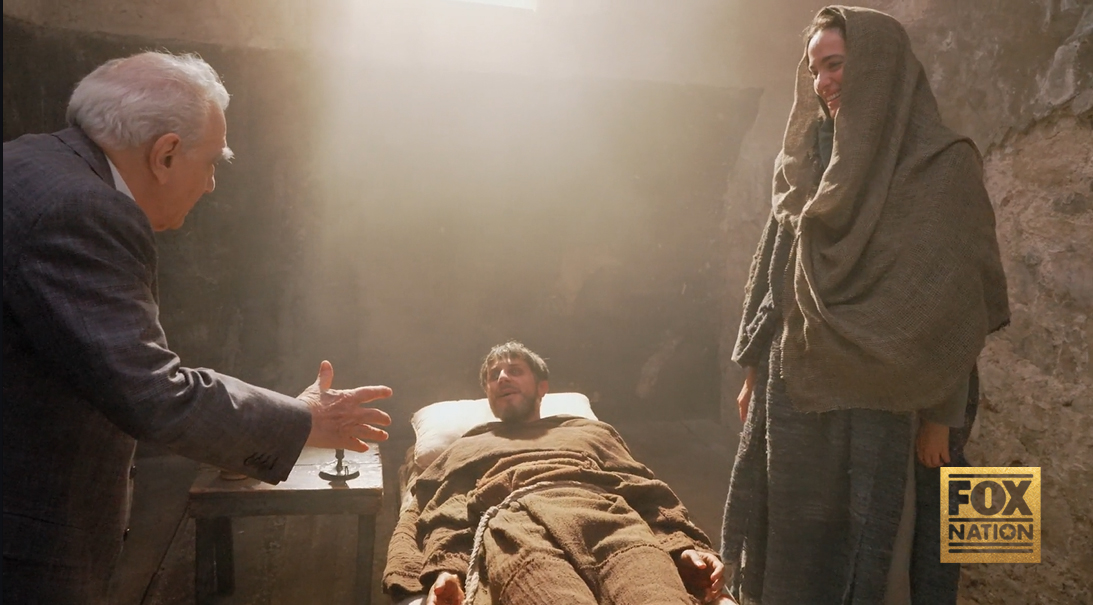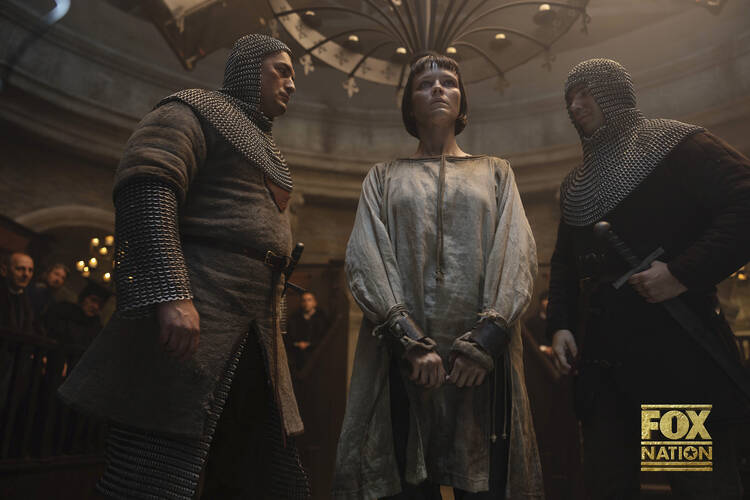“Martin Scorsese Presents: The Saints” takes its audience on a journey both grippingly emotional and deeply grounded in historical facts. Weaving together beautifully shot scenes from the saints’ lives with historical contextualization in the form of narration from Mr. Scorsese, “The Saints” showcases the radically faithful expressions of love for which each saint is known.
While the saints’ personal journeys are convincingly portrayed as evidence of miraculous dedication to God, their humanity and trials are honestly depicted as well. After watching each of the seven episodes, the audience will be struck by not only the example of the saints, but also by the ringing truth that no matter our past, there is hope for our future.
The first four episodes, which cover Joan of Arc, John the Baptist, Sebastian and Maximilian Kolbe, premiered in the fall of 2024; the final three, on Francis, Moses the Black and Mary Magdalene, are available this spring. Each episode runs around 45 minutes long, with roughly 35 minutes focused on the storyline and 10 minutes dedicated to a conversation between Mr. Scorsese and friends. His conversation partners include Mary Karr, a memoirist; Paul Elie, an author; and James Martin, S.J., editor at large at America. Discussing topics such as the process of sainthood and how to reconcile ourselves with the darker elements of a saint’s story, the conversation segments are well-crafted conclusions to each episode.
Mr. Scorsese’s mastery of the art of film carries into the series. (Mr. Scorsese serves as executive producer; the episodes are directed by Elizabeth Chomko and Matti Leshem.) The gruesome depictions of warfare, torture, martyrdom and concentration camps are difficult to watch but portray the real pain and darkness of these moments in history. Tempering this darkness is Mr. Scorsese’s signature style of using light as a storyteller. Every episode shows the eyes of the saints as illuminated, shining with revelation and purpose. Backlighting often frames the saints to create a haloed effect, and beams of light touch their faces when a vision or revelation occurs.

The brilliance of the makeup and costume design team enhances these moments. The attention to detail and historical accuracy of the clothing worn, down to the grime caking the bodies and faces of the characters, create a captivating, cohesive visual effect. Multiple episodes utilize the contrast between a filthy face and shining eyes to communicate the dedication of the saint amid the darkness of their surroundings, particularly for Joan of Arc, John the Baptist, Maximilian Kolbe and Francis.
The acknowledgment of historical elements such as political machinations and the sexist and racist attitudes of the time helps to ground the audience in the reality of the saints’ lives. Mr. Scorsese’s narration explains the significance of these factors in rich detail throughout the show; he emphasizes the courage and conviction of each saint within their moment in history.
Having not been raised in the Catholic tradition, my knowledge of many of the featured saints was cursory at best. Even the stories that seemed familiar at first held elements that surprised me. After watching each episode, I would research the saint’s life to determine the accuracy of the portrayal. I was repeatedly pleased to discover that Mr. Scorsese remained true to the historical and theological facts. Within the show, Mr. Scorsese notes when history is vague or contradictory reports exist, and he cites sources for his information if it departs from the traditional storyline.
One such departure takes place in the final episode, on Mary Magdalene. In the conversation following this episode, Mr. Scorsese readily admits that some blanks needed to be filled in Mary Magdalene’s story and that the Gnostic Gospels’ account were used to do so, particularly the Gospel of Mary. This influence is most clearly seen in the depiction of Mary as having a deeper understanding of Jesus than the disciples do, and this fact causing some tension among Christ’s followers and inspiring the jealousy of Peter. The episode does a beautiful job of emphasizing Mary’s importance to Jesus, the followers of Christ and the early church. While the episode does draw from sources beside Scripture, nothing within it directly contradicts Scripture; instead, it reimagines and reinforces Mary’s wisdom and spiritual strength as the apostle to the apostles.
A thread that unites the episodes is each saint’s deeply personal relationship with God. Their spirituality led them to radical expressions of faith and dedication to God’s will, and their callings loomed larger than society’s constraints. This is familiar ground for Mr. Scorsese. In a previous interview with Father Martin for America, Mr. Scorsese spoke about the theme of personal faith in his film “Silence.” He stated that the heart of the book “is the depth of faith, the struggle for the very essence of faith…. The vehicle that one takes towards faith can be very helpful—the church, the institution of the church, the sacraments—but ultimately, it has to be yourself. And you have to find that faith and that relationship with Jesus with yourself because ultimately that’s the one you face.”
This dedication to fostering a personal relationship with Christ and embracing the unique callings of faith permeates each episode. Joan of Arc holds steadily to her convictions, even when under trial for heresy. John the Baptist is shown fleeing Jerusalem, and his Levite roots, due to the corruption of the Sadducees and Pharisees, instead proclaiming the coming of the Savior in the wilds of the desert. Sebastian chooses his love of God over his love for the Roman state. Kolbe lives out the Gospel’s message of love for one’s neighbors by housing Jews in Nazi-occupied Poland and ultimately giving his life for another. Francis forms a new order where he eschews both the hierarchies of leadership and all material goods. Moses the Black chooses to flee from a life of sin and embrace a life reconciled with Christ. And the portrayal of Mary Magdalene paints the picture of a woman who goes against all cultural norms to follow Christ boldly and speak with bravery regardless of her society’s sexist expectations.
Sebastian exemplifies this dedication to his personal faith over the religion of the empire as he covertly converts others to Christianity while serving the Roman emperor Diocletian. Famed for being intolerant of all religions beside the ancient Roman gods, Diocletian persecuted Christians. When explaining the historical significance of Diocletian’s rule, Mr. Scorsese notes that Diocletian wanted “to bring back the glory days of the Pax Romana—to make Rome great again.” Then the scene immediately cuts to a lounging Diocletian glittering in gilded armor and seated on a golden throne.
This subtle comparison with our current president was fascinating for many reasons—not least of which is that the primary streaming platform for “The Saints” is Fox Nation. Nothing else within the series alluded to current politics, but this commentary lingered in my mind.
While each saint is shown to possess exceptional devotion to their calling, both the filmed narratives and conversations afterward were honest in addressing the humanity of the saints. Joan of Arc’s recanting of her visions is shown, as is her bitter regret and ensuing acceptance of her fate. Kolbe’s mistakes around promoting antisemitic beliefs are portrayed within his story. Yet his caring response in housing, feeding and dying in solidarity with the Jewish people is depicted as well.
When discussing the humanity of the saints, as real people who made mistakes and did hard things, Father Martin remarks, “The Jesuits have a saying, ‘We’re all loved sinners.’… And you know the old quote, ‘No saint without a past, no sinner without a future.’” Mary Karr replies with raised hands: “You’re giving me so much hope!” This sentiment runs throughout the show: There is hope for us all.
“Martin Scorsese Presents: The Saints” is available to stream on Fox Nation. The series contains violence and nudity (Episodes 4 and 5) and brief sexual content (Episode 6).
Read next: Martin Scorsese discusses his journey with the saints.








